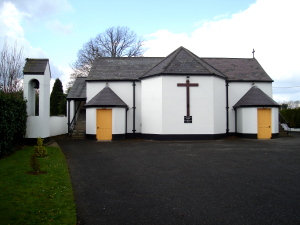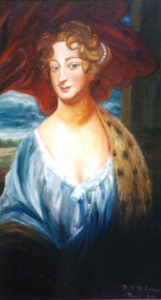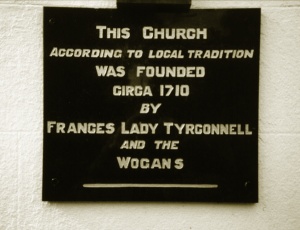The Founding of Rathcoffey Chapel
Published in Le Chéile, 2001
The origins of Rathcoffey Church are obscure but according to local tradition it dates from 1710 in the early years of the penal period. Tradition also suggests that Lady Frances the Duchess of Tyrconnell and the Wogans’ founded the Chapel.
Both Lady Tyrconnell and the Wogans were staunch Catholics and had a strong desire to end religious persecution in the country. In the penal period the leading Catholic gentry were permitted to have a private Chapel in their house and also a registered priest in certain circumstances. John Wogan had a private Chapel in his house and had given sureties for registered priests at the time. It is likely Lady Tyrconnell visited the Wogans occasionally as she had connections with the family and more than likely attended Mass in the Wogan private Chapel in Rathcoffey Castle. The parish priest of the Rathcoffey area at that time Fr. Laurence Walsh who lived at Graiguepottle on the Wogan Estate would have officiated at this Chapel. So Lady Tyrconnell would have been aware of the plight of the local people who were without a chapel and would have to attend religious services outdoors in the countryside. It is likely that Lady Tyrconnell and John Wogan founded the Chapel by converting a stable on the Wogan estate as a private Chapel and this could have been done legally and within the system. Furthermore with the involvement of Lady Tyrconnell whose sister was a close associate of Queen Anne the authorities were not likely to take action.
The building was sited at the foot of Rathcoffey hill on what was then the main Clane to Kilcock road at a point where a junction led to Rathcoffey mill. The original Chapel was the part of the Church on either side of the altar extending from the north gable wall to the south gable wall. This building was known to have had a thatched roof and evidence of an upstairs or loft came to light at the time of a renovation when marks of ceiling joists were found on the inside of the building. It would also indicate that the original building had a low ceiling and the walls were raised in height at some period in its history to provide adequate ventilation in the Church. The original seating consisted mainly of a bench type seating around the wall on the inside of the Chapel.
The first documentary mention of the Church dates from 1731 and states, “There is a private popish Chapel at Rathcoffey where Fr. Francis Dillon constantly officiates.” Fr. Dillon lived in the parish at that time and had been Parish Priest for 10 years.
The two people closely involved in establishing the Chapel also contributed to establishing other religious houses. It is likely John Wogan was involved in establishing a penal Chapel in Kilcock that was built on his property before 1714. It is also known that Lady Tyrconnell in the period after 1712 founded a convent for the Poor Clare Order of nuns in her house in North King St. Dublin. According to tradition she entered the convent as a nun and died in her convent cell in 1731.
With the relaxation of the more severe of the penal laws by the mid-seventeen hundreds the continued existence of Rathcoffey Chapel was secure and today this Church survives as the oldest Catholic Church in the diocese of Kildare and Leighlin.



